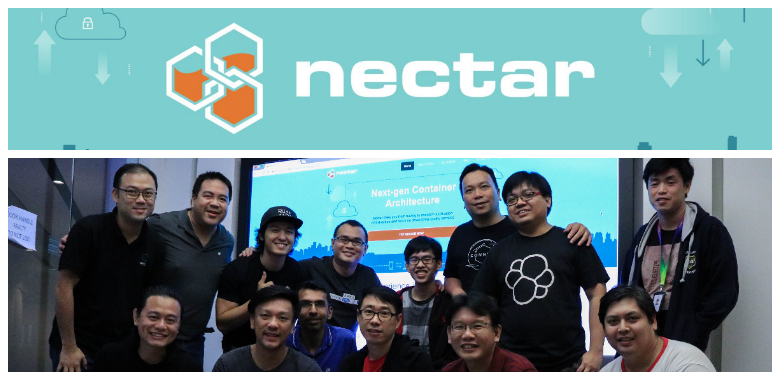A centralised ‘host in the machine’ is helping government agencies fast-track digital services

TL: DR: Built by GovTech engineers, NECTAR is a centralised hosting platform that greatly simplifies the development of government digital services. A platform-as-a-service, NECTAR gives developers the flexibility to tweak applications as often as they need to. NECTAR is based on container technology, an up-and-coming technology with many advantages over traditional hosting methods
What do digital data vault MyInfo, career-matching service MyCareersFuture and government crowdsourcing portal eCitizen Ideas! have in common?
Although they serve very different purposes, these applications are all hosted on NECTAR, the Singapore government’s centralised hosting platform for public sector digital services. An example of a platform-as-a-service (PaaS), NECTAR will soon form part of a centrally managed tech stack aimed at helping government agencies build digital services more quickly and easily.
Developed by GovTech’s Government Digital Services division, NECTAR allows project teams from various government agencies to build and run applications without the hassle of maintaining their own infrastructure, said Mr Chia HM from the NECTAR team.
“This frees up project teams to focus on building applications, which are ultimately what is most important,” said Mr Chia, who was speaking at the Public Sector Infocomm Seminar on in March 2018.
The evolution of hosting
In traditional physical hosting, each project team had to build and manage everything needed for applications to run, including servers, storage, networking, operating systems, runtime software and data, said Mr Chia.
Things got a little better with the advent of virtual machines, which provide virtualised computing resources over the internet and hence allow project teams to farm out certain components of the stack, such as servers, storage and networking.
Today, PaaS systems like NECTAR further lighten the burden on project teams by allowing everything from hardware to operating systems and runtime software to be centralised.
“Your project teams really only need to concentrate on the two most critical portions—the application itself and the data,” said Mr Chia.
Deploy from your desk
One huge advantage of PaaS systems is their agility, said Mr Chia. Consider what happens when a developer is tasked with making an urgent fix to an application. In traditional systems, after coding the fix, the developer must travel to a data centre to deploy it, as well as run tests to make sure that the problem has indeed been solved.
Should more tweaks be needed, our weary developer returns to his desk, writes another fix, and again ventures out to the data centre to deploy it. “This cycle can repeat itself several times, and if the project is complex, the process can drag on and take weeks or even months,” said Mr Chia.
In contrast, for applications hosted on NECTAR, developers simply log into the NECTAR portal, initiate a build of the changes they have made, and click ‘deploy’. “That’s it—you haven’t left your desk,” said Mr Chia, adding that further tweaks can be made just as easily.
This flexibility can save teams a significant amount of time and effort, and is especially useful for projects that are about to go live—a time when changes often fly fast and furious, said Mr Chia. “Through the use of the NECTAR portal, deployment becomes a streamlined, straightforward affair.”
Contain your excitement
At the core of NECTAR is Docker container technology, an up-and-coming alternative to virtual machines, said Mr Chia. Container ‘units’ are in effect digital packages that contain all the necessary compute power, code and settings needed to run an application.
NECTAR runs on a monthly subscription model, and users can vary the number of container units they buy according to their needs, said Mr Chia. This is particularly useful for applications that experience peak periods—a school registration system, for example, might see the most activity and hence require more units at the start of the school year.
In addition, container units can also be dynamically assigned to different parts of the application, such as testing and production, said Mr Chia.
“Back in the day, when you had traditional hosting, you had to procure servers for the testing environment and servers for the production environment. But when you’re not doing testing, the testing servers sit idle,” he explained.
“With NECTAR, you can reallocate these resources to the production environment and boost it so that it can run faster. You’re always sure that your resources are not left idling.”
At the same time, container technology also helps to reduce incompatibilities between the testing and production environments. “What this means is that there is less risk of the application breaking due to configuration or environmental differences,” said Mr Chia.
A host of features
NECTAR comes with many other features, including built-in security tools, a suite of common services such as email and file transfer, and a design that is compatible with government compliance standards, said Mr Chia.
He added that the platform has already received positive feedback from users; the MyInfo team, for example, estimated that hosting on NECTAR cut development time from a year to four months.
For interested project teams who may have reservations about adopting a new system, Mr Chia said that the NECTAR technical consultation team is happy to help. “We have people attached to every single project to provide advice and consulting if you run into problems. We do understand that this is new technology, and there is a need to bridge this gap,” he concluded
https://www.tech.gov.sg/media/technews/a-centralised-host-in-the-machine-is-helping-government-agencies-fast-track-digital-services
